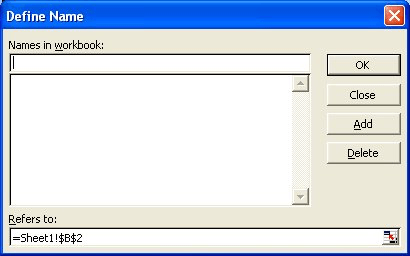Written by Allen Wyatt (last updated December 29, 2020)
This tip applies to Excel 97, 2000, 2002, and 2003
Besides allowing you to define a name that refers to a cell or cell range, Excel allows you to define names that refer to formulas or constant values. For instance, suppose you have a constant you will be using in your worksheet quite a bit--the standard commission rate for staff sales people, which is 8.5%. To define a name for this constant, follow these steps:

Figure 1. The Define Name dialog box.
The constant is now available for use in your worksheet. You can then use it in formulas just as you would any other defined name.
ExcelTips is your source for cost-effective Microsoft Excel training. This tip (2659) applies to Microsoft Excel 97, 2000, 2002, and 2003.

Program Successfully in Excel! This guide will provide you with all the information you need to automate any task in Excel and save time and effort. Learn how to extend Excel's functionality with VBA to create solutions not possible with the standard features. Includes latest information for Excel 2024 and Microsoft 365. Check out Mastering Excel VBA Programming today!
When processing data in a worksheet, you may have a need to know what the smallest (lowest) even value in a range is. You ...
Discover MoreFiguring out how to average data that is in a contiguous range of cells is easy. When the data is spread over a group of ...
Discover MoreNeed to know the directory (folder) in which a workbook was saved? You can create a formula that will return this ...
Discover MoreFREE SERVICE: Get tips like this every week in ExcelTips, a free productivity newsletter. Enter your address and click "Subscribe."
There are currently no comments for this tip. (Be the first to leave your comment—just use the simple form above!)
Got a version of Excel that uses the menu interface (Excel 97, Excel 2000, Excel 2002, or Excel 2003)? This site is for you! If you use a later version of Excel, visit our ExcelTips site focusing on the ribbon interface.
FREE SERVICE: Get tips like this every week in ExcelTips, a free productivity newsletter. Enter your address and click "Subscribe."
Copyright © 2026 Sharon Parq Associates, Inc.
Comments